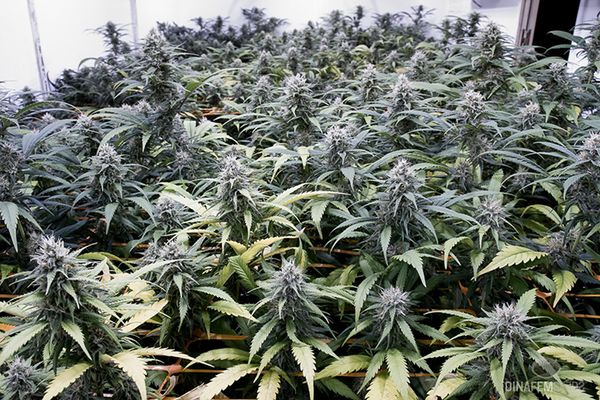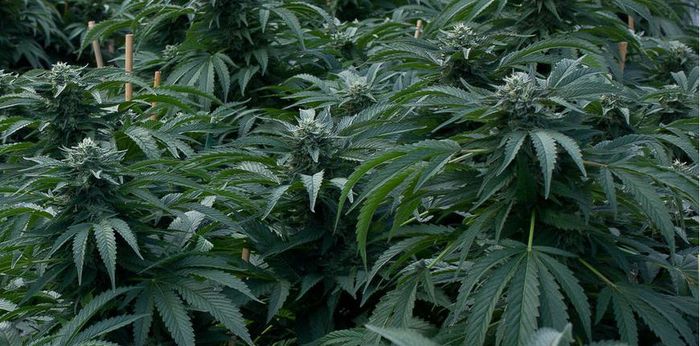- Organic cannabis growing means growing your plants without using pesticides or synthetic nutrients and additives and allowing them to thrive on purely natural elements instead. More and more growers are embracing this environmentally friendly technique.
- As you must have guessed from the title of this guide on organic marijuana growing, the first step is good organisation of the growing area. In this post you will find some tips to help you make the most out of your indoor growing environment and get the best results when growing cannabis organically. Let’s get down to it!

If you want to take full advantage of your grow room when growing organically, there are some decisions you will have to make even before you start sowing. We have checked with John Mulch, one of our breeders and an expert organic cannabis grower, and he has given us some advice on how to organise the growing area properly. These are the logistical aspects you need to take into consideration:
- Space / Intensity: adapting the light intensity to the size of the grow tent is key, as having the wrong lighting can cause overheating or slow down the development of the plants if they are not getting enough light.
Here are some helpful parameters:
-250 watt light: this is the right power to use when the growing space is very limited, for instance in 80 x 80 cm grow tents. At such low power, Mulch recommends using SCROG, SUPER CROPPING or FIMMING to maximise the yield.
-400 watt light: this middle power light is well suited for 80 cm² to 1m² grow tents.
-600 watt light: for 1.2 to 1.5 m² grow tents. With this high-power light, there is a risk of temperature becoming too high (over 29 ºC) and plants suffering from overheating. Temperature is something that must always be born in mind, but this is particularly true when using 600 watt lights.
- Genetics / Space: each strain has its own traits and needs, so adapting the calendar, the space and the growing technique to the genetics you have chosen to grow will save you a lot of trouble. Nowadays, it is hard to find 100% sativa or indica strains in the market, anyway most of the hybrids the banks of seeds sell lean towards one phenotype or the other.
- Extraction is another aspect to consider if you want to avoid overheating. The higher the light intensity, the higher will have to be the extraction capacity. You can use the value m³/hour as a guide to work out the capacity you need:
-250 watt light: 300-360 m³/h
-400 watt light: 360-500 m³/h
-600 watt light: 500-800 m³/h
If you like indicas…
S.O.G
Indica-dominant strains are shorter and thicker than sativas and have a longer growing period. In this case SOG (Sea of Green) is a good method to use, as it reduces the growing time and maximises the yield. With this type of genetics, it is good to place more plants per square metre than usual and focus the production on the central stem in order to obtain big, bulky colas. This is what John Mulch recommends:
-9 to 12 plants per square metre in 7 to 10 litre pots.
The idea is to prune the lower branches of the plant as they grow – they must be 40 cm at least – in order to direct the energy to the central bud.
Used with indica-dominant plants, which have longer growing periods but shorter flowering, SOG is quite a timesaver.
If you want to try out this method, we recommend:
Pruning the apex
Our breeder recommends this technique for indicas with Afghani parentage such as Bubba Kush and Purple Afghan Kush. This genetics tend to be leafy and close the branches inwards, and by cutting the apex you force the plant to open up, improving ventilation and light penetration and therefore increasing the yield. If you use this technique, you will have to extend the vegetative period (six weeks approximately) and bear in mind that the plant will take up more space. The procedure is as follows:
-Do the first pruning at the sixth internode.
-Do the second pruning at the third internode.
-Do the third pruning at the third internode.
This will force the central trunk to split up into eight branches that will develop their own buds, the plant growing like a tree, more leafy and horizontal, which will result in an increased yield. Another important step is removing the unnecessary leaves and branches that may block light penetration.
If you are considering pruning your Bubba Kush and Purple Afghan Kush plants, our breeder recommends as follows:
He suggests two options:
- 4 plants per square metre in 30 to 40 litre pots.
- 6 plants per square metre in 15 to 20 litre pots.
If you want to try out this method, we recommend:

If you prefer sativas…
SCROG
Compared to indicas, sativas have a shorter vegetative period and a longer flowering. They are also more vigorous and slender, which allows for better ventilation and light penetration. Something you need to be very vigilant with is stretch, which occurs during the first weeks after switching from growing to flowering, namely when you change the light cycle from 18 hours light/6 hours dark to 12/12.
One common problem with this type of strains is that they tend to grow too much, which can cause havoc in indoor growing, where the space is limited. A good way to keep this excessive growth under control is SCROG, as it allows to have all the buds at the same height and improve light distribution. The only thing you need to do is weave the branches of the plant through a net. This is what our breeder recommends if you are planning to use this technique with your sativa strains: Internal arrangement of the grow tent with sativa strains:
-4 to 6 plants per square metre in 15 to 20 litre pots.
The key to a successful sativa crop indoors lies in getting the timing of the growing period right. Plant development depends upon many factors, so we cannot give exact figures, but at a "normal" rate sativas should be ready for flowering in about three weeks, with an approximate size of 20-25 cm. As usual, the best advice is watching the plants and trying to work out their needs.
If you want to try out this method, we recommend:
If autoflowerings are really your thing…
The ratio between the size of the plant and that of the roots is paramount in organic growing. A well-developed, healthy root system with enough space to spread out will have a positive impact on the rest of the plant, particularly in the case of autoflowerings. This is why you should consider using a big pot. Something growers appreciate about growing autoflowerings organically is that buds develop fewer leaves. Our breeder himself has obtained less leafy flowers when growing organically.
Here is his recommendation on the internal arrangement of the grow tent:
-4 to 6 plants per square metre in 15 to 20 litre pots.
If you want to learn more about our autoflowering strains, you can have a look at Dinafem's autoflowering catalogue through this link.



Comments from our readers
Read comments in other languages:
Did you like this post?
Your opinion about our seeds is very important to us and can help other users a lot (your email address won't be made public).